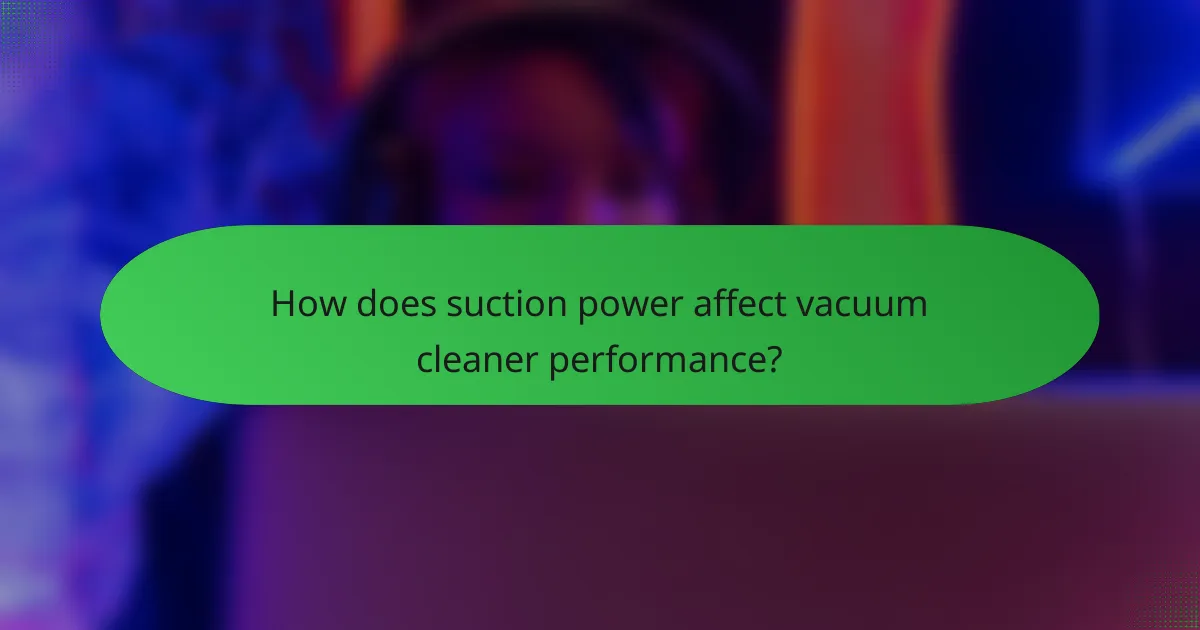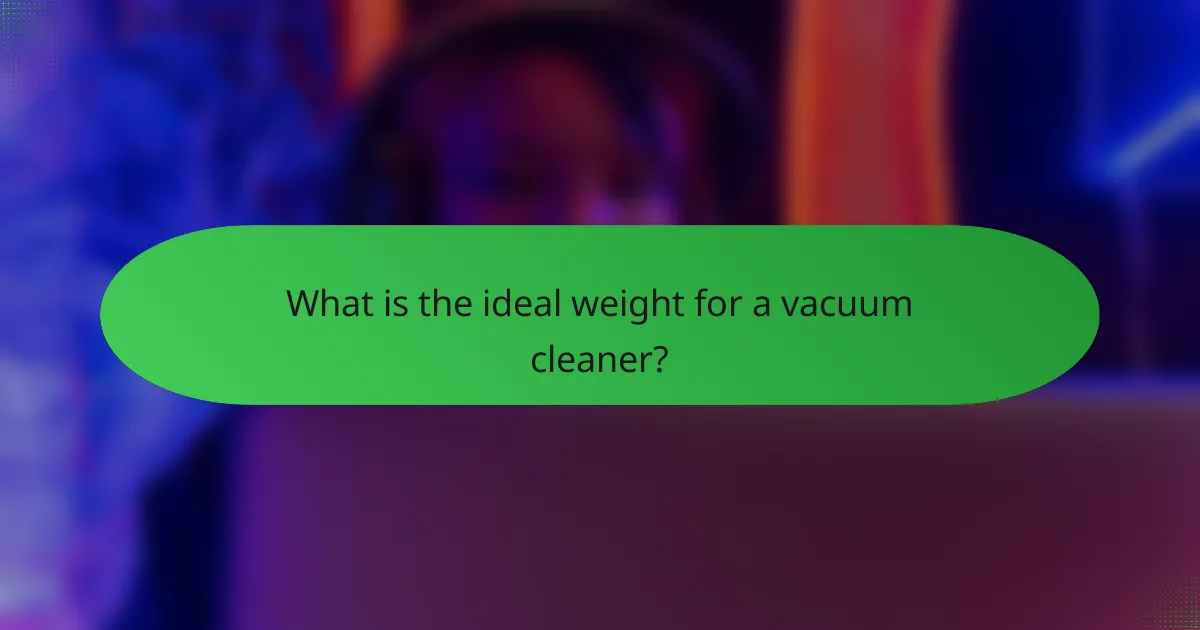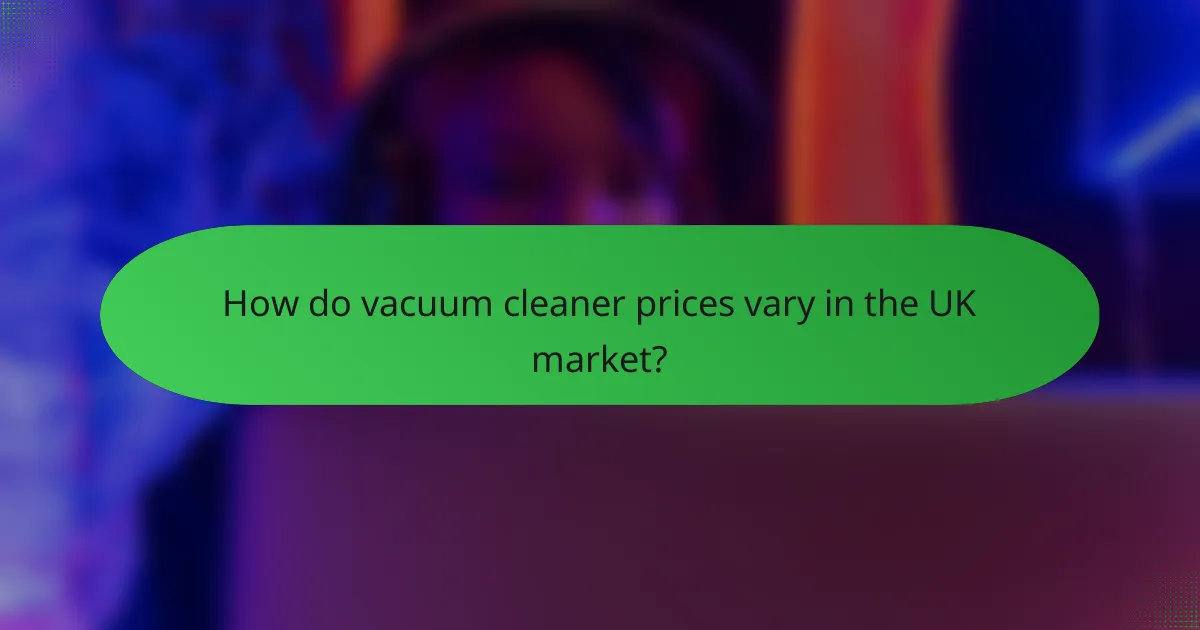Choosing the right vacuum cleaner involves understanding the different types available, such as upright and robot models, each designed to meet specific cleaning needs. Suction power plays a crucial role in a vacuum’s effectiveness, particularly on carpets, while the weight of the machine can affect its maneuverability and ease of use. Finding the perfect balance between these factors will enhance your cleaning experience.

What are the best vacuum cleaner types for homes in the UK?
The best vacuum cleaner types for homes in the UK include upright, robot, canister, handheld, and stick vacuums. Each type has unique features and benefits, making them suitable for different cleaning needs and preferences.
Upright vacuum cleaners
Upright vacuum cleaners are popular for their powerful suction and large capacity, making them ideal for cleaning carpets and larger areas. They typically have a robust design and can handle various floor types, but their weight may be a consideration for some users.
When choosing an upright vacuum, look for models with adjustable height settings for different carpet types and consider the bagless options for easier maintenance. Brands like Dyson and Shark offer models that are well-regarded in the UK market.
Robot vacuum cleaners
Robot vacuum cleaners provide a hands-free cleaning solution, automatically navigating around your home to pick up dirt and debris. They are particularly useful for busy households, as they can be scheduled to clean while you are away.
While robot vacuums may not have the same suction power as traditional models, many come with smart features like app control and mapping technology. Popular options in the UK include the Roomba and Roborock series, which offer good performance for their size.
Canister vacuum cleaners
Canister vacuum cleaners are versatile and often lighter than upright models, making them easier to maneuver around furniture. They typically have a long hose and various attachments, which are great for cleaning stairs, upholstery, and hard-to-reach areas.
When selecting a canister vacuum, consider the suction power and the type of flooring in your home. Brands like Miele and Henry are known for their reliability and strong performance in the UK market.
Handheld vacuum cleaners
Handheld vacuum cleaners are compact and designed for quick clean-ups, making them ideal for small messes, cars, and tight spaces. They are lightweight and easy to store, but their battery life and suction power can be limited compared to larger models.
Look for handheld vacuums with strong suction and good battery life, especially if you plan to use them frequently. Popular choices include the Black+Decker Dustbuster and the Dyson V7 Trigger.
Stick vacuum cleaners
Stick vacuum cleaners combine the convenience of lightweight design with decent suction power, making them suitable for quick clean-ups and everyday use. Many models are cordless, providing freedom of movement without the hassle of cords.
When choosing a stick vacuum, consider the battery life and whether it converts to a handheld option for added versatility. Brands like Shark and Dyson offer popular stick vacuums that are well-suited for homes in the UK.

How does suction power affect vacuum cleaner performance?
Suction power is a critical factor in vacuum cleaner performance, influencing its ability to pick up dirt, debris, and allergens. Higher suction power generally leads to more effective cleaning, especially on carpets and rugs, but it can also impact energy consumption and maneuverability.
Higher suction power for deep cleaning
Vacuum cleaners with higher suction power are more effective for deep cleaning, particularly on thick carpets where dirt can become embedded. Models with suction ratings in the range of 200-300 air watts typically excel in this area, making them suitable for homes with pets or heavy foot traffic.
However, it’s essential to balance suction power with the vacuum’s weight and design. Heavier models may be more powerful but can be cumbersome to use, especially for extended periods.
Optimal suction for different surfaces
Different surfaces require varying levels of suction for optimal cleaning. For instance, hard floors generally need less suction compared to carpets. A vacuum cleaner that offers adjustable suction settings can be beneficial, allowing users to switch between modes based on the surface being cleaned.
As a guideline, a suction power of around 100-150 air watts is often sufficient for hard floors, while carpets may benefit from higher settings. This versatility helps ensure effective cleaning without damaging delicate surfaces.
Impact on energy efficiency
Higher suction power can lead to increased energy consumption, which may affect overall efficiency. Many modern vacuum cleaners are designed to provide strong suction while maintaining energy efficiency, often rated under energy standards like ENERGY STAR.
When selecting a vacuum, consider models that balance suction power with energy use. Look for those with energy-efficient motors that provide adequate cleaning performance without significantly increasing electricity costs.

What is the ideal weight for a vacuum cleaner?
The ideal weight for a vacuum cleaner typically ranges from 5 to 15 pounds, depending on the model and intended use. Lightweight models are easier to maneuver, while heavier models often provide more stability and suction power.
Lightweight models for easy maneuverability
Lightweight vacuum cleaners, usually weighing under 10 pounds, are designed for effortless handling and transport. These models are ideal for quick clean-ups and are often preferred for multi-level homes where carrying the vacuum up and down stairs is necessary.
Examples include stick vacuums and handheld models, which are convenient for reaching tight spaces and are often cordless, enhancing their portability. However, they may sacrifice some suction power compared to heavier models.
Heavier models for stability and power
Heavier vacuum cleaners, typically weighing over 10 pounds, tend to offer greater suction power and stability. These models, such as upright vacuums, are often more effective for deep cleaning carpets and larger areas.
While they may be more challenging to maneuver, their robust design can handle tougher debris and larger messes. Users should consider their cleaning needs and whether the added weight is worth the enhanced performance.
Weight considerations for elderly users
For elderly users, the weight of a vacuum cleaner is a significant factor in maintaining independence while cleaning. Models that weigh less than 10 pounds are generally recommended to reduce physical strain and the risk of injury.
Additionally, features such as ergonomic handles and swivel steering can further enhance usability. It’s advisable for elderly users to test different models to find one that feels comfortable and manageable for their specific needs.

What features should I consider when choosing a vacuum cleaner?
When selecting a vacuum cleaner, consider features such as suction power, weight, filtration systems, noise levels, and whether it uses bags or is bagless. These factors significantly impact cleaning efficiency and user experience.
Filtration systems
Filtration systems are crucial for capturing dust, allergens, and other particles. High-efficiency particulate air (HEPA) filters are recommended for those with allergies, as they can trap up to 99.97% of particles as small as 0.3 microns. Regular maintenance and replacement of filters are essential to maintain optimal performance.
Consider the type of filtration when choosing a vacuum cleaner. Some models offer multi-stage filtration, which can enhance air quality by filtering out finer particles. Always check if the filters are washable or need to be replaced, as this affects long-term costs.
Noise levels
Noise levels can vary significantly between vacuum cleaners, typically ranging from around 60 dB to over 80 dB. Quieter models are preferable for homes with children or pets, as they minimize disturbances during cleaning. Look for vacuum cleaners labeled as “quiet” or with noise-reduction technology.
When assessing noise levels, consider the environment in which you will be using the vacuum. If you live in an apartment or shared space, a model with lower decibels will be more considerate to neighbors. Always check user reviews for real-world noise experiences.
Bagless vs. bagged options
Bagless vacuum cleaners are convenient as they eliminate the need for purchasing bags, but they require regular emptying and cleaning of dust containers. Bagged options tend to hold more debris and can be more hygienic, as they contain dust and allergens until disposal.
When deciding between bagless and bagged, consider your cleaning habits and preferences. If you prefer less maintenance, a bagged vacuum may be ideal. Conversely, if you want to avoid ongoing costs, a bagless model could be more economical in the long run.

How do vacuum cleaner prices vary in the UK market?
In the UK market, vacuum cleaner prices can range significantly based on type, features, and brand. Generally, you can find budget models starting around £50, while high-end options may exceed £500, reflecting differences in suction power, weight, and technology.
Budget-friendly options
Budget-friendly vacuum cleaners typically range from £50 to £150. These models often include basic features and decent suction power, making them suitable for light cleaning tasks. However, they may lack advanced functionalities like HEPA filters or smart technology.
When selecting a budget vacuum, consider the weight and maneuverability, as lighter models are easier to handle. Brands like Vax and Bissell often offer reliable options in this price range.
Mid-range vacuum cleaners
Mid-range vacuum cleaners usually fall between £150 and £300. These models often provide a balance of performance and features, such as improved suction power and additional attachments for various surfaces. They may also include bagless designs and better filtration systems.
Look for models from brands like Dyson or Shark, which are known for their durability and efficiency. These vacuums are suitable for regular household cleaning and can handle pet hair effectively.
High-end models
High-end vacuum cleaners can cost £300 and above, with some premium models reaching over £1,000. These vacuums often feature advanced technology, such as robotic capabilities, powerful suction, and smart home integration. They are designed for optimal performance and convenience.
Investing in a high-end model from brands like Miele or Roomba can provide long-term benefits, especially for larger homes or those with pets. Consider features like noise levels and maintenance costs when choosing a high-end vacuum.

What are the emerging trends in vacuum cleaner technology?
Emerging trends in vacuum cleaner technology focus on enhanced suction power, smart features, and weight reduction. Innovations include advanced robotics, improved filtration systems, and energy-efficient designs that cater to consumer needs for convenience and performance.
Upright Vacuum Cleaners
Upright vacuum cleaners are gaining popularity due to their powerful suction and ease of use on carpets. They typically weigh between 10 to 20 pounds, making them manageable for most users. Newer models often feature bagless designs and advanced filtration systems to capture allergens effectively.
When choosing an upright vacuum, consider the suction power, which can range from 100 to 300 air watts. A higher suction power is beneficial for deep cleaning carpets, while a lower power may suffice for hard floors. Look for models with adjustable height settings to accommodate various carpet types.
Robot Vacuum Cleaners
Robot vacuum cleaners are increasingly popular for their convenience and automation. These devices usually weigh around 5 to 10 pounds and can clean autonomously, navigating around furniture and obstacles. Many models are equipped with smart technology, allowing users to control them via smartphone apps.
When selecting a robot vacuum, consider the battery life, which typically lasts from 60 to 120 minutes, depending on the model and cleaning mode. Suction power varies, with many robots offering around 1500 to 3000 Pa, sufficient for most daily cleaning tasks. Look for features like scheduling and mapping for optimal performance.
Suction Power
Suction power is a critical factor in vacuum cleaner performance, influencing how effectively dirt and debris are removed. Measured in air watts or pascals (Pa), effective suction power typically ranges from 100 to 300 air watts for upright vacuums and 1500 to 3000 Pa for robot vacuums.
For optimal cleaning, choose a vacuum with sufficient suction for your flooring type. Higher suction is essential for carpets, while lower suction can be effective on hard surfaces. Regular maintenance, such as cleaning filters and brushes, can help maintain suction efficiency.
Weight Considerations
The weight of a vacuum cleaner significantly impacts its usability and maneuverability. Upright vacuums generally weigh between 10 to 20 pounds, while robot vacuums are lighter, usually around 5 to 10 pounds. Consider your physical ability and the areas you need to clean when selecting a vacuum.
For those with mobility concerns or multi-level homes, lightweight models or robot vacuums may be more suitable. Always check the weight specifications before purchasing to ensure that the vacuum meets your needs for ease of handling and storage.
